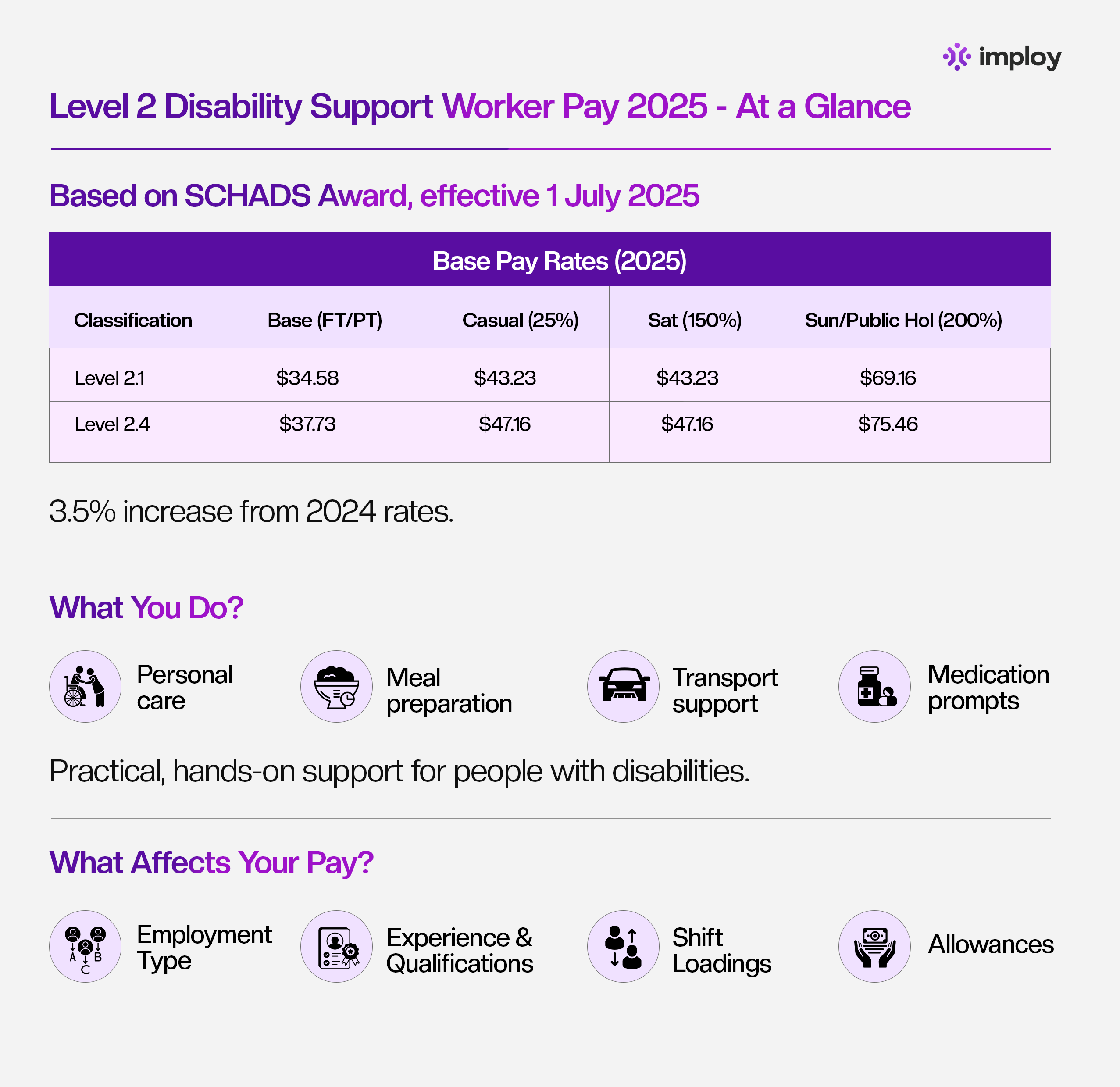Level 2 Disability Support Worker Pay in 2025: What You Need to Know?
Find out 2025 Level 2 Disability Support Worker pay rates under the SCHADS Award. Learn about allowances, penalty rates, and how imploy helps you stay compliant.

Disability support work continues to be one of the fastest-growing and most rewarding career paths in Australia. As the sector evolves under the NDIS, so too do pay rates, employment conditions, and compliance standards.
If you’re a Level 2 Disability Support Worker, understanding your pay and entitlements under the SCHADS Award is essential - whether you work for an NDIS provider or operate independently.
In this guide, we’ll break down the 2025 Level 2 pay rates, what affects your earnings, and how imploy can help you stay compliant and confident in your role.
What is a Level 2 Disability Support Worker?
Under the Social, Community, Home Care and Disability Services (SCHADS) Award, Level 2 describes a worker who provides practical, hands-on support to people with disabilities, often requiring some experience or a formal qualification like a Certificate III in Individual Support (Disability).

Typical Level 2 duties include:
- Personal care (bathing, dressing, hygiene).
- Community access and transport support.
- Assisting with meal preparation and household tasks.
- Medication prompts and wellbeing monitoring.
- Promoting social inclusion and independence.
Level 2 is often considered an entry-to-intermediate role in the disability sector - an important stepping stone toward Level 3 or coordinator positions.
2025 Pay Rates for Level 2 Disability Support Workers
Every year, the Fair Work Commission reviews national minimum wages under the SCHADS Award to ensure they reflect the cost of living and industry demand.
From 1 July 2025, the SCHADS Award received a 3.5% wage increase, improving pay rates across all classification levels, including Level 2 Disability Support Workers.
If you work under this award (which most NDIS providers follow), your pay rate depends on your classification level, pay point, and employment type - whether you’re casual, part-time, or full-time.
Below is the current minimum wage guide for Level 2 support workers as of July 2025
SCHADS Award Pay Rates (as of 1 July 2025)
Source: Fair Work Ombudsman - SCHADS Award 2025 Pay Guide.
What These Rates Mean?
- Base hourly rates apply to part-time and full-time employees.
- Casual rates include a 25% loading in place of paid leave.
- Penalty rates apply when working weekends, evenings, or public holidays.
Level 2.4 represents the top pay point within the Level 2 classification, typically earned by experienced workers with extra duties or training.
In practice, this means that a Level 2.4 casual worker could earn up to $47.16 per hour, or more when working weekends or public holidays.
Example
If you worked a Saturday shift as a Level 2.3 part-time employee:
- Base rate = $36.75/hour
- Saturday rate (150%) = $55.13/hour
- So, an 8-hour Saturday shift earns around $441 before tax.
These rates set a national minimum standard, but some NDIS providers or enterprise agreements may offer higher pay, especially for specialised roles or regional areas.
For up-to-date information, you can always check Fair Work’s Pay Calculator.
What Affects Your Pay Rate?
Not every Level 2 worker earns the same. Your exact rate depends on several key factors:
1. Employment Type
Your employment type - casual, part-time, or full-time - affects how much you earn and what benefits you receive under the SCHADS Award.
Casual workers get a 25% loading on top of the base rate to make up for not receiving paid leave. For example, if the base rate is $35/hour, a casual earns about $43.75/hour. The trade-off is less job security and no paid holidays or sick leave.
Part-time employees work regular hours each week (less than 38) and earn the base rate. They receive paid annual and sick leave, as well as penalty rates for weekends and public holidays.
Full-time employees work about 38 hours per week, earning the same base rate as part-time staff but with full leave entitlements, superannuation, and stable hours.
In short: casuals earn more per hour, but part-time and full-time roles offer greater stability and benefits over time.
2. Experience & Qualifications
Higher pay points (e.g. Level 2.3 or 2.4) apply if you’ve completed extra training or taken on more complex responsibilities. Completing short courses in medication support, manual handling, or behaviour management can also boost your classification.
3. Shift Loadings
Under SCHADS, you earn penalty rates for evenings, weekends, and public holidays:
- Saturdays: 150% of base rate
- Sundays: 200% of base rate
- Public holidays: 250% of base rate
4. Allowances
Extra payments apply for specific work conditions, such as:
- Travel between clients
- Sleepover shifts
- First aid duties
- Laundry or meal allowances
You can use imploy’s NDIS invoicing templates to make sure your allowances are included correctly when billing plan managers or participants.
How 2025 Pay Rates Compare to 2024?
Here’s how the SCHADS pay rates changed year-over-year:
In 2025, the average base pay for Level 2 workers went up by 3.5% compared to 2024. This small increase helps to cover the rising cost of living, but many support workers say it’s still not enough.
As prices for housing, fuel, and groceries continue to go up, workers are asking for better pay that matches the important work they do every day. The increase is a positive step, but there’s still a long way to go to make sure care workers are paid fairly for their skills and dedication.
Career Growth Beyond Level 2
Working as a Level 2 Disability Support Worker gives you valuable frontline experience - building trust with participants, developing communication skills, and understanding the NDIS system from the ground up. But it doesn’t have to stop there. The disability support sector offers clear pathways for career advancement and higher earning potential as you upskill and take on new responsibilities.
Level 2 is a great starting point, but there’s plenty of room to grow. You can move into:
- Level 3 Support Worker: Providing higher-level or specialised care.
- Team Leader / Coordinator: Supervising staff or managing support plans.
- Specialist roles: Behaviour Support Practitioner, Community Program Coordinator.
- Independent contractor opportunities: Work directly with participants under self- or plan-managed NDIS funding.
Upskilling through Certificate IV or Diploma courses can help increase both your earning potential and job flexibility.
If you’re considering expanding your role or even starting your own NDIS business, check out our detailed guide: How to Set Up an NDIS Business in Australia?
How imploy Supports Disability Support Workers?
At imploy, we’re here to make the admin side of disability support work simple, compliant, and stress-free.
With imploy, you can:
- Access ready-to-use policy and procedure templates for SCHADS and NDIS compliance.
- Create professional invoices and service agreements in minutes.
- Stay informed with regular updates on pay rates and compliance changes.
- Explore helpful blogs and FAQs designed for NDIS professionals.
Explore our full library of resources here: imploy’s NDIS Provider Resources.
Final Thoughts
In 2025, Level 2 Disability Support Workers in Australia will earn between $34-$38 per hour, depending on their pay point, experience, and employment type.
Understanding your classification, entitlements, and allowances is key to ensuring you’re paid fairly and progressing confidently in your career.
With the right knowledge and professional development, you can build a rewarding and sustainable future in the disability support sector - while continuing to make a positive impact in people’s lives.
FAQs
1. What is the base hourly rate for Level 2 support workers in 2025?
Between $34.58 and $37.73 per hour, depending on your classification.
2. Do Level 2 workers get paid more on weekends and public holidays?
Yes. Under the SCHADS Award, you receive 150% of your base rate on Saturdays, 200% on Sundays, and up to 250% on public holidays.
3. What qualifications do I need to work as a Level 2 support worker?
Most employers require a Certificate III in Individual Support (Disability) or equivalent experience. Additional training like First Aid, Medication Administration, or Manual Handling can increase your pay and employability.
4. How can I move from Level 2 to Level 3?
To progress, you’ll typically need extra training, more responsibility, or experience supporting participants with complex needs. Earning a Certificate IV in Disability or Community Services can help you qualify for Level 3 roles.
5. What are the key differences between Level 2.1 and Level 2.4 pay points?
Level 2.1 is usually for new or less experienced workers, while Level 2.4 applies to those with more experience, training, or added responsibilities. The difference can be over $3 per hour.
6. How can I check if my pay rate is correct?
Use the Fair Work Pay Calculator or refer to the SCHADS Award Pay Guide.
7. Are travel and meal allowances included in the hourly rate?
No. These are separate allowances under the SCHADS Award. If you travel between clients or work long shifts, you may be entitled to additional payments for travel, meals, or laundry.
8. Where can I find compliant templates and tools for my NDIS business?
Visit imploy’s NDIS Templates Hub for policies, forms, and documentation designed to meet NDIS and SCHADS requirements.





